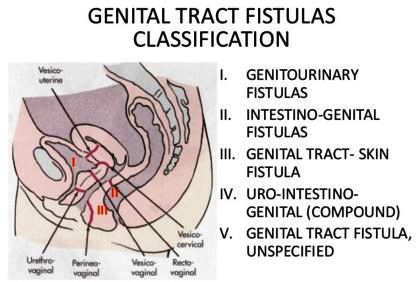Vaginal fistula
What is vaginal fistula?
The fistula development at the vaginal wall termed as vaginal fistula. Depending upon the location of the vaginal fistula, the following are the different types of vaginal fistula: Physical and social consequences are common for sufferers.
- Vesicovaginal fistula: The opening of the vaginal fistula in the urinary bladder and then it is termed as vesicovaginal fistula.
- Ureterovaginal fistula: The opening of the vaginal fistula in the urinary tract and then it is termed as urethrovaginal fistula.
- Urethrovaginal fistula: The opening of the vaginal fistula in the urethra (the duct which helps to excrete urine from the body, it is termed as urethrovaginal fistula.
- Rectovaginal fistula: The opening of the vaginal fistula at the rectum is called a rectovaginal fistula.
- Colovaginal fistula: The opening of the vaginal fistula in the colon is called colovaginal fistula.
- Enterovaginal fistula: The opening of the vaginal fistula at the small intestine is called a enterovaginal fistula.

Image 1 – Classification & Locations of Vaginal Fistulas
Symptoms
- Vaginal fistula isn’t created any pain sensation.
- Urine as well as fecal material discharged through the vaginal route. Urine incontinence is common in case of vesicovaginal fistula and fecal incontinence is common in rectovaginal fistula.
- Gas and foul smelling discharge are common with enterovaginal, colovaginal and rectovaginal fistula.
- Frequent incidence of infection in the geneto-urinary organs.
Causes
The possible causes are:
Injuries during labor
Tearing of the perineum during vaginal delivery causes an injury in the small intestine, bacterial infection or injury at the episiotomy produce greater risk to develop a vaginal fistula. Fistula development during delivery also may lead to wound in the anal sphincter and causes rectovaginal fistula.
Crohn’s disease
The Crohn’s disease is important to factor to increase the risk of vaginal fistula, specifically rectovaginal fistula. The presence of Crohn’s disease causes the lining of the GI tract inflammation.
Malignancy and radiation treatment
Malignant tissue development at the vagina, uterus, cervix, anal canal or rectum causes development of a vaginal fistula. Radiation therapy also leads to vaginal fistula development within the two years of the development.
Surgery
Surgical intervention in vagina, perineum, rectum or anus leads to vaginal fistula.
Other causes
Diverticulitis (swelling at the GI tract), Ulcerative colitis (chronic inflammation of colon or rectum) and any accidental trauma in vaginal wall lead to develop a vaginal fistula.
Diagnosis
For diagnosis purpose, thorough knowledge of medical history is required. The detail communication about sign and symptom discussion require analyzing the patient discomfort. During discussion with doctor, detail information about previous surgery, accidental trauma or associated infection must be discussed.
- For physical examination, doctors usually use a speculum for checking the internal wall of the vagina.
- For leakage identification, using of dye is a common diagnostic measure.
- Urine culture and urinalysis is conducted in the presence of infection.
- Complete blood count requires identifying the signs of infection.
For getting the clear image and confirmation X-ray, endoscope and/or MRI are conducted. These also help to identify the associated tissue damage and treatment planning.
Treatment
Surgical treatment is the only option for repairing vaginal fistula. Before a surgical intervention, it needs to check the associated tissue. For healing the associated tissue before surgery antibiotic therapy mainly prescribed.
Inflammatory bowel syndrome should be manageable, before surgical intervention.
In case of rectovaginal fistula, the colostomy is required to conduct for rectal passage clearing. After healing of the fistula, then inserted bag is taken out.
After fistula repair surgery, be sure to follow your doctor’s instructions. See your doctor right away if you have signs of infection, such as a fever, tenderness, swelling, or redness.
Surgery
Two surgical procedures, transvaginal and transabdominal are mainly conducted to repair the vaginal fistula. Before proceeding surgery, general anesthesia is recommended to make the patient unconscious.
Transvaginal
Catheterization done via urethral route and by using a speculum, the vagina is opened up and then fistula wall will be removed. After completion suturing and special vaginal dressing is put into easy healing.
Transabdominal
Lower abdominal wall incision is conducted and after re-sectioning the connection between the vagina and associated organ is manipulated. The abdominal wall suturing insertion of the catheter or stent may place in ureters for passage of urine.
https://healthsurgical.com/wp-content/uploads/2016/01/vaginal-fistula-repair.jpg
Image 2 – Surgical Repair of Vaginal Fistula
Vaginal Fistula Pictures
https://healthsurgical.com/wp-content/uploads/2016/01/recto-vaginal-fistula-photo.jpg
Image 3

Image 4 – Anatomical Location of Uterus, Vagina and Fistula
References
- http://www.webmd.com/women/tc/vaginal-fistula-topic-overview
- Vaginal fistula at http://www.mayoclinic.org/diseases-conditions/vaginal-fistulas/basics/definition/con-20037566
- Bladder and Bowel Foundation Vaginal and Recto Vaginal at https://www.bladderandbowelfoundation.org/bladder/bladder-conditions-and-symptoms/vaginal-and-recto-vaginal-fistulas/
- http://www.forwarduk.org.uk/key-issues/fistula/
- Repair of Vesico-Vaginal Fistula at http://health.cvs.com/GetContent.aspx?token=f75979d3-9c7c-4b16-af56-3e122a3f19e3&chunkiid=619700
